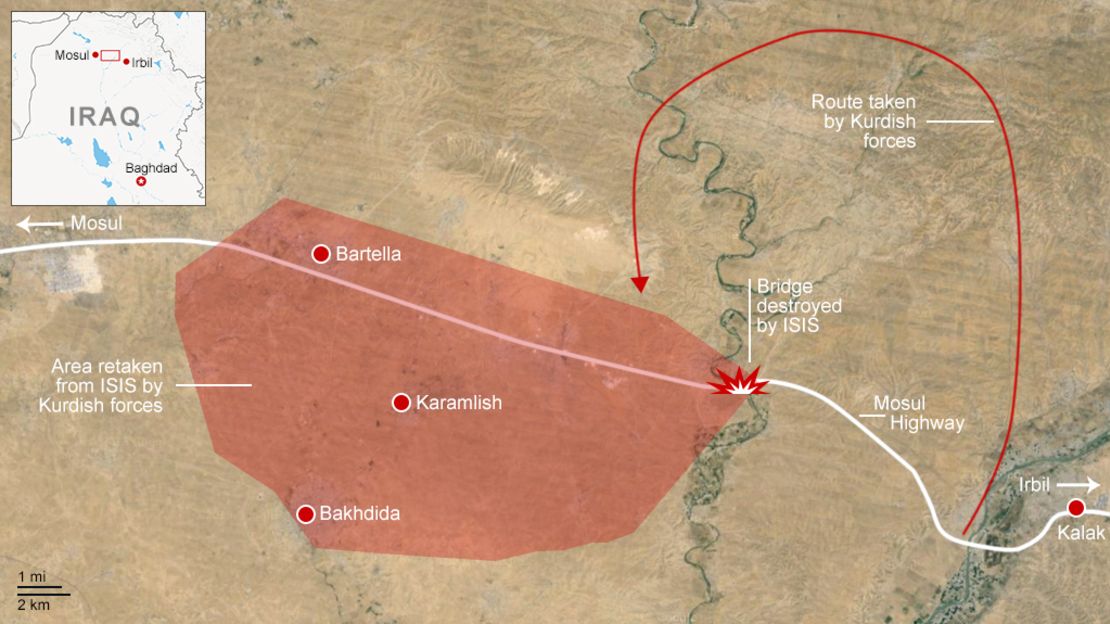Story highlights
U.S. airstrikes hit southwest of Baghdad for a second day, military says
U.S. warplanes provide support; Peshmerga reclaim villages
ISIS claims to have shot down a Syrian military fighter jet
Comminuqué: International fight against ISIS will continue "by any means necessary"
It began before dawn: One thousand troops taking up position.
The goal? Push ISIS fighters back toward Mosul and farther from Irbil, the capital of Iraq’s Kurdish region.
ISIS had already destroyed a bridge linking the two cities a month ago, hoping to prevent any opposing force from advancing on Mosul – the country’s second largest city.
But the Kurdish fighting force, known as the Peshmerga, found another way, taking a long route around, traveling on dirt roads through mountainous areas – first north, then west, then back south, past the bridge.

They stopped near villages seized by ISIS, which refers to itself as the Islamic State. Most people had fled or been forced out of the area, the Peshmerga told CNN.
Only fighters for the terrorist group and its sympathizers remained. ISIS, also known as ISIL, has seized large swaths of land as part of its effort to create a caliphate – an Islamic state – that stretches from western Syria to eastern Iraq.
Once the Kurdish forces were in place, the firing began – a series of loud explosions of mortar and artillery, says CNN producer John Fiegener, who along with CNN correspondent Anna Coren embedded with the Peshmerga.
“Then you hear the aerial bombs, and those are bigger. Then you hear the small arms – the machine guns.” That sound indicates the Peshmerga forces have reached the areas where ISIS fighters are holed up, he said.
It lasted hours. “You see a lot of fires, smoke coming out – whether it’s a fuel station or a gas tanker.”
Hidden bombs and snipers
But ISIS, known for its ferocious acts of terror and military tactics, expected Pesherga forces to arrive at some point, so the militants were prepared with hidden bombs and snipers.
“ISIS had a tanker full of explosives that they tried to drive into the Peshmerga,” Fiegener says. It caused a “really huge explosion,” followed by a “very large cloud of dust.”
The United States played an instrumental role in the operation Tuesday, with airstrikes that shattered some ISIS positions.
“At least two jets were flying the entire time that we were there,” Fiegener said.
There were two U.S. airstrikes northwest of Irbil, according to the U.S. military. That’s the same area where the Peshmerga operation was underway.
The strikes targeted an armored vehicle and ISIS fighting position, according to the military.
The Peshmerga estimated it faced about 100 ISIS fighters, killing between 20 and 30 of them. Six or seven members of the Kurdish forces were killed in explosions, a commander said.
The Peshmerga did not say whether they had captured any ISIS fighters.
The Kurdish forces took back enough terrain to include the bridge site and nearby villages.
ISIS says it downed Syrian fighter jet
But in Syria, ISIS claimed a victory of its own. The group said it shot down a Syrian military fighter jet.
Photos distributed by the Reuters news agency and the London-based Syrian Observatory for Human Rights show ISIS fighters posing with pieces of what is described as debris from the aircraft.
The observatory, based in London, said the plane was shot down while it was conducting airstrikes on the ISIS stronghold Raqqa, in Syria.
The incident came as world leaders worked to develop strategies to combat the terror group, which claims it has established an Islamic caliphate.
If ISIS is allowed to fester, it will threaten “our homeland,” U.S. Defense Secretary Chuck Hagel warned Congress on Tuesday.
U.S. strikes close to Baghdad
U.S. military aircraft targeted ISIS positions southwest of Baghdad for a second day.
Three airstrikes targeted ISIS vehicles and weapons, as well as a small ground unit and two small boat on the Euphrates River that was resupplying the extremist fighters, according to the military.
President Barack Obama announced last week that the United States would lead “a broad coalition to roll back this terrorist threat” and that U.S. airstrikes against ISIS would expand from Iraq into Syria.
The United States has said nearly 40 nations have agreed to contribute to the fight against ISIS, which has seized control of large areas of northern Iraq and Syria. But it remains unclear exactly which countries are on that list and what roles they’ll play.
ISIS put its brutality on display once again over the weekend, posting a video showing the beheading of British aid worker David Haines and threatening the life of another hostage from the United Kingdom.
It was the third videotaped killing of a Western hostage released in less than a month. The latest killing, ISIS said, was “a message to the allies of America.”
What will world do about ISIS?
How many more Western captives is ISIS holding?
What should the world know about Muslims?
CNN’s Jethro Mullen, Barbara Starr and Jim Sciutto contributed to this report.





![[File photo] This undated file image posted on a militant website on Jan. 14, 2014, which has been verified and is consistent with other AP reporting, shows fighters from the al-Qaida linked Islamic State of Iraq and the Levant (ISIL) marching in Raqqa, Syria.](https://media.cnn.com/api/v1/images/stellar/prod/140910130410-isis-march-syria.jpg?q=x_0,y_0,h_1125,w_2000,c_fill/h_144,w_256)

